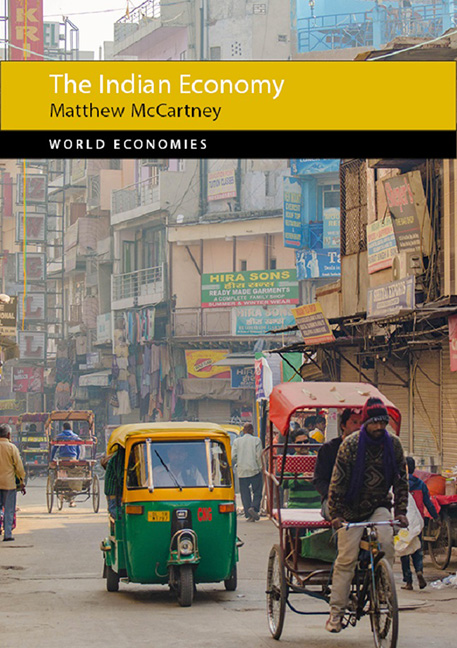Book contents
- Frontmatter
- Dedication
- Contents
- Acknowledgements
- List of Tables and Figures
- Maps
- 1 Introducing the Indian economy, 1947–2017
- 2 The Indian economic story since 1947
- 3 Measuring economic and human development
- 4 The form of the Indian economy
- 5 Human factors in the Indian economy
- 6 Making the Indian economy unique
- Conclusion: prospects for the Indian economy
- References
- Index
4 - The form of the Indian economy
Published online by Cambridge University Press: 09 August 2023
- Frontmatter
- Dedication
- Contents
- Acknowledgements
- List of Tables and Figures
- Maps
- 1 Introducing the Indian economy, 1947–2017
- 2 The Indian economic story since 1947
- 3 Measuring economic and human development
- 4 The form of the Indian economy
- 5 Human factors in the Indian economy
- 6 Making the Indian economy unique
- Conclusion: prospects for the Indian economy
- References
- Index
Summary
In perhaps the most widely cited political economy work seeking to understand the economic importance of India’s social structure Pranab Bardhan wrote in 1984 that there were three dominant proprietary classes (DPCs). These DPCs were the industrial bourgeoisie, rich farmers and professionals. The “professionals” class included civil servants and private-sector white collar workers. Bardhan estimated that the three DPCs belonged roughly to the top two deciles of the population. In 1975/6 this was 5 per cent of rural households and 17.6 per cent of urban households by income or 3.8 million rural and 3.7 million urban households. Bardhan argues that the three DPCs were the dominant classes in India and had a key role in influencing the process of government policy making. The key hypothesis of Bardhan was that “when diverse elements of the loose and uneasy coalition of the dominant proprietary classes pull in different directions and when none of them is individually strong enough to dominate the process of resource allocation, one predictable outcome is the proliferation of subsidies and grants to placate all of them” (1984: 61). The result of this is that even with extensive resource mobilization through savings and taxation, “the bulk of these resources have been frittered away in current expenditures” (ibid.). The influence of the DPCs on government, he argued, was evident. For example, farmers receive direct subsidies to maintain farm support prices and subsidies to reduce the cost of fertiliser, irrigation water, and diesel. Indirect subsidies for the professionals can be seen in the growth of public-sector employment and salaries. Bardhan notes that since the beginning of the 1960s real per capita income of central government employees increased two and a half times faster than that of per capita income in the country. Bardhan argues that the “Indian public economy has thus become an elaborate network of patronage and subsidies” (ibid.: 65). There is a clear link here with the various discussions of public investment as a driver of economic growth in India (see Chapter 2). The DPCs compel the government to extend to them more generous subsidies, this forces the government to cut back on public investment and economic growth declines.
- Type
- Chapter
- Information
- The Indian Economy , pp. 107 - 128Publisher: Agenda PublishingPrint publication year: 2019



